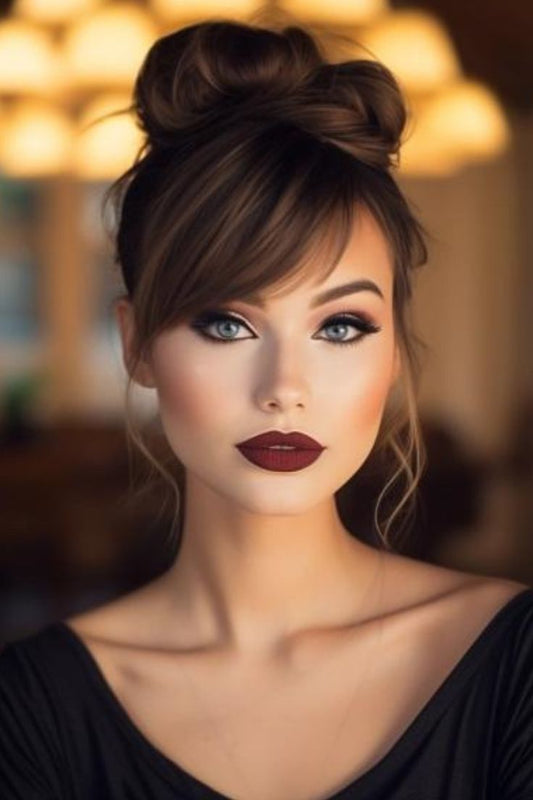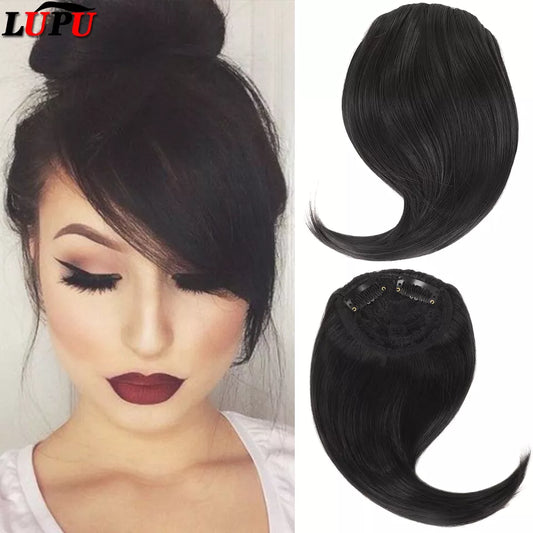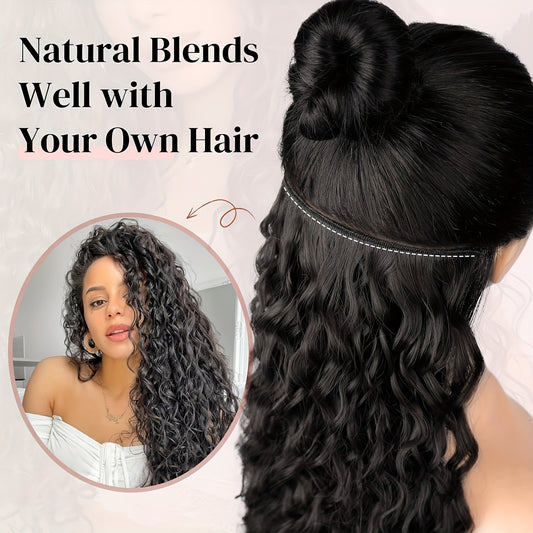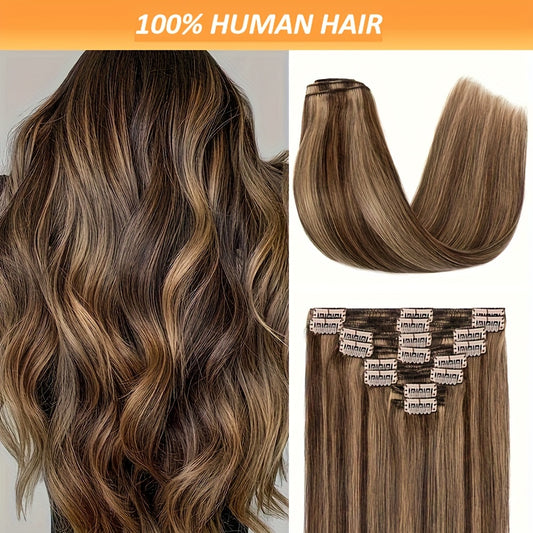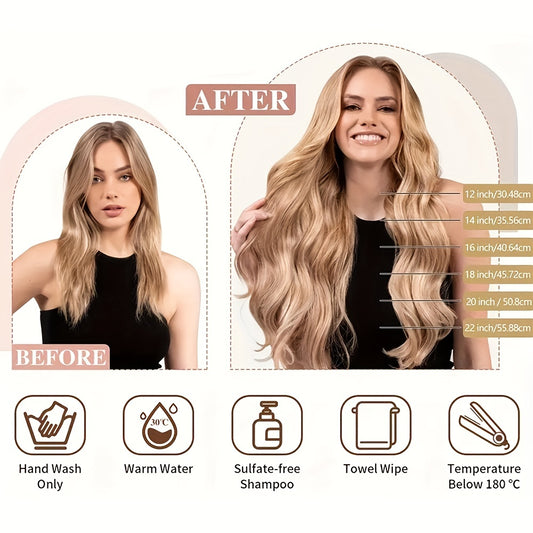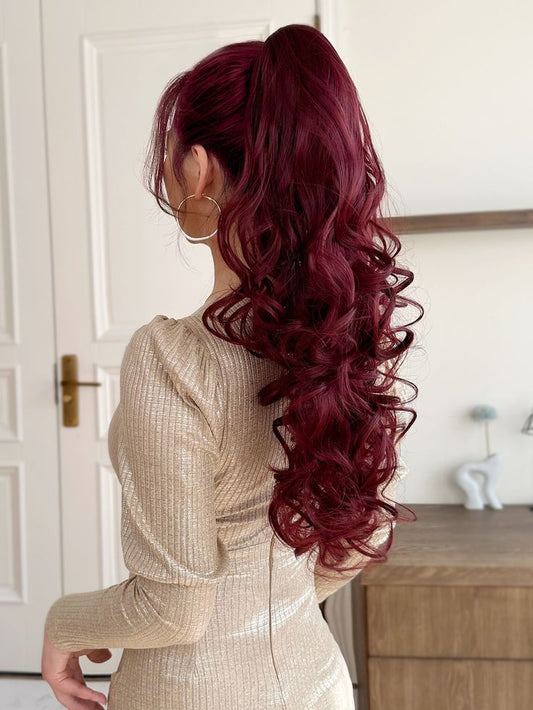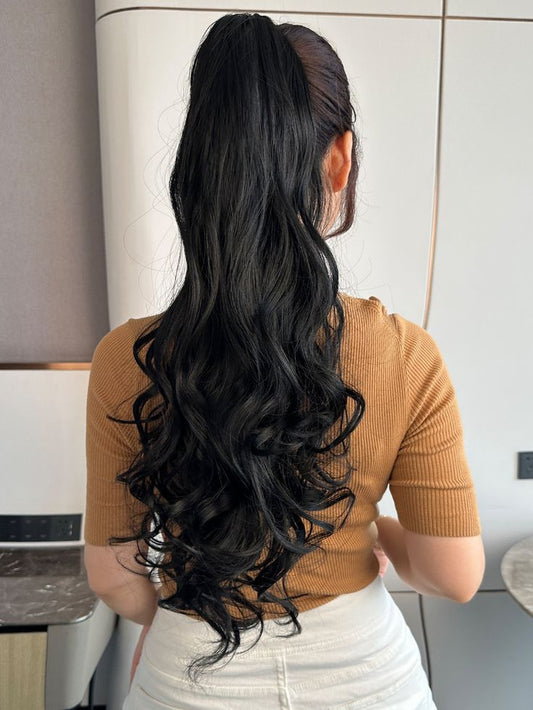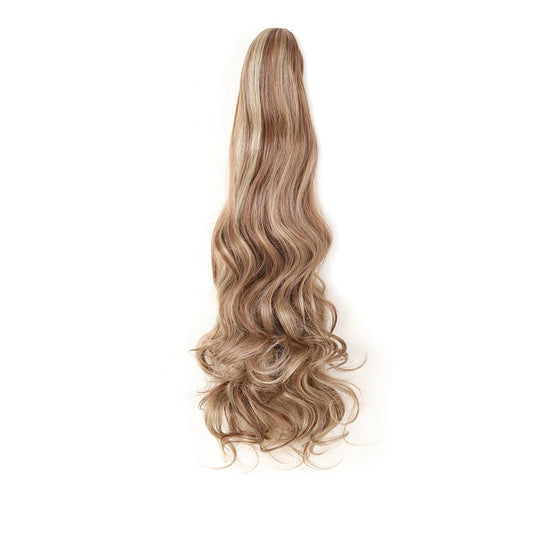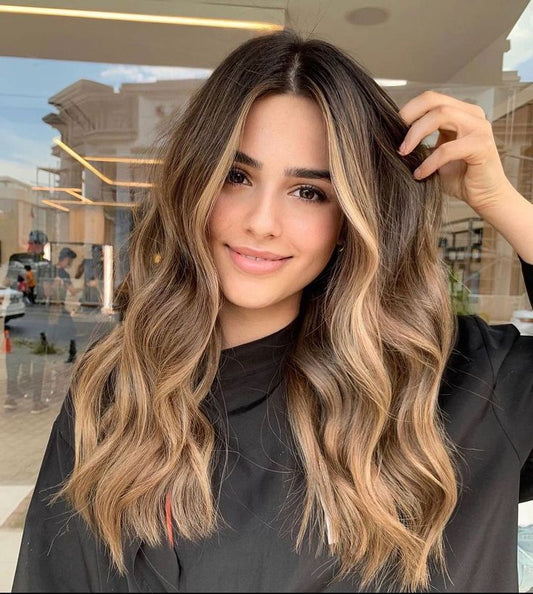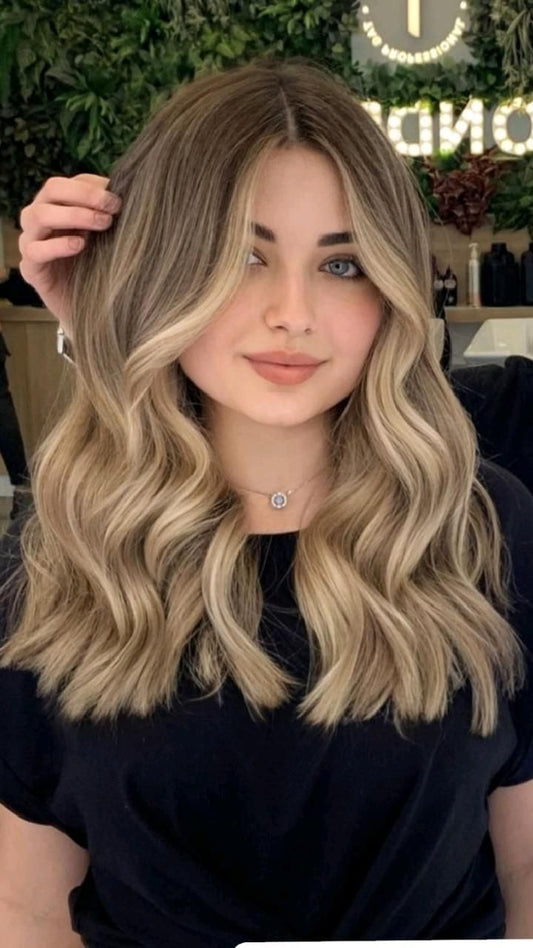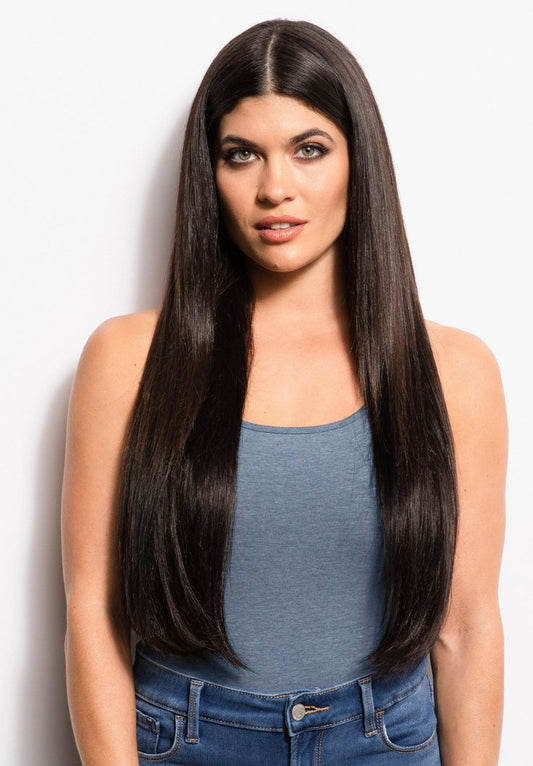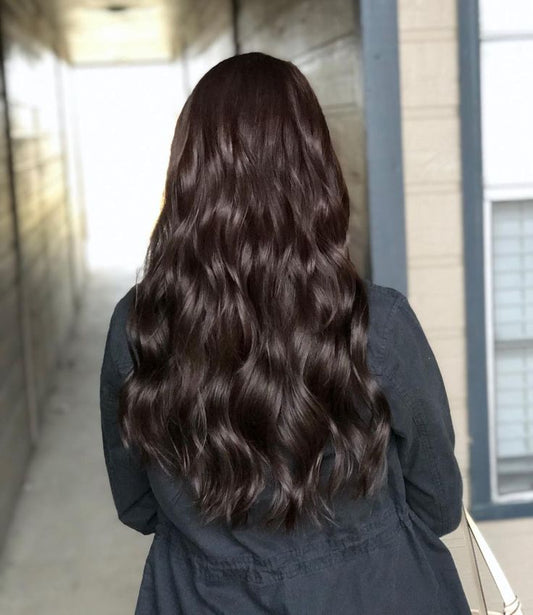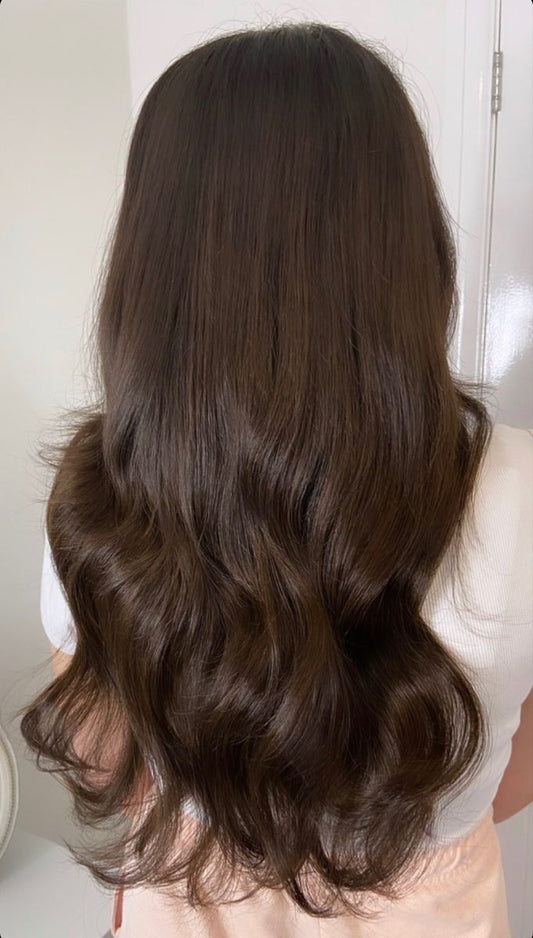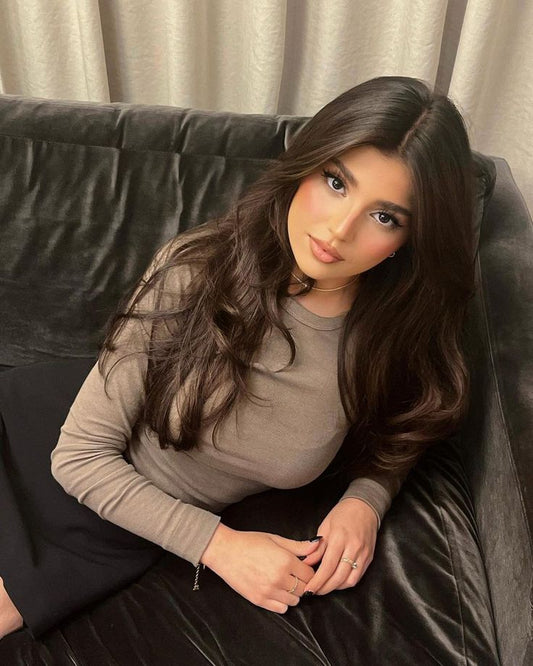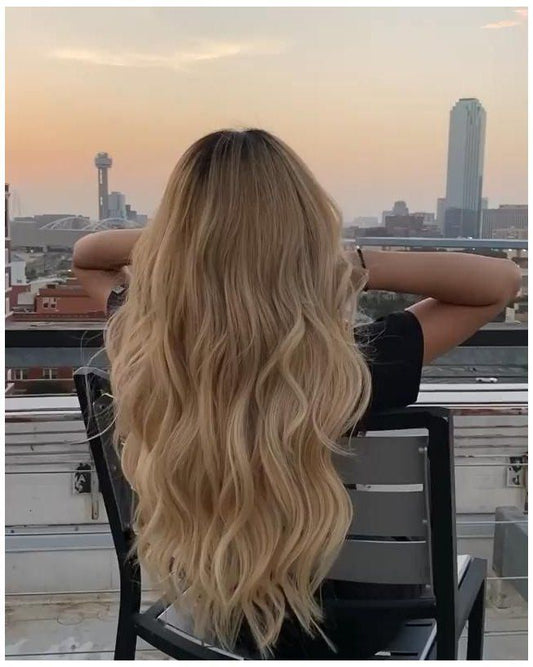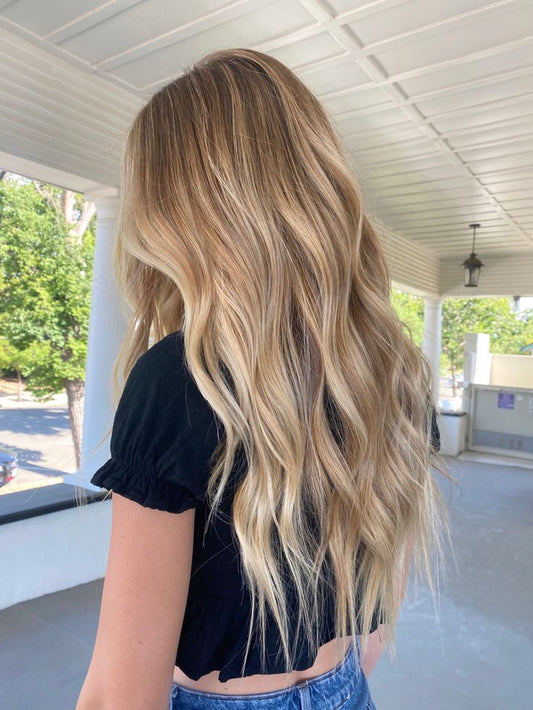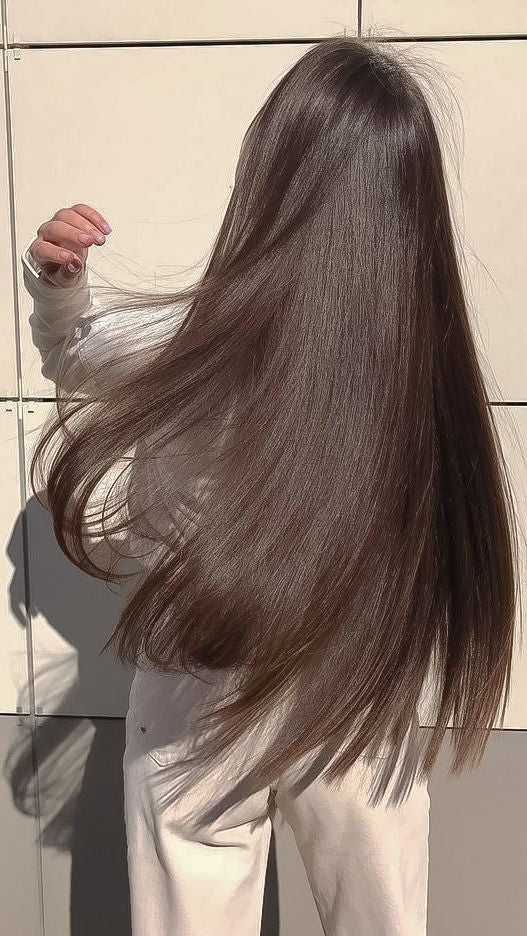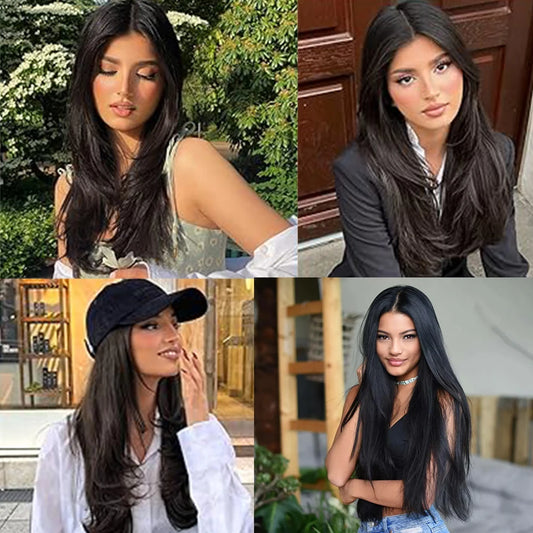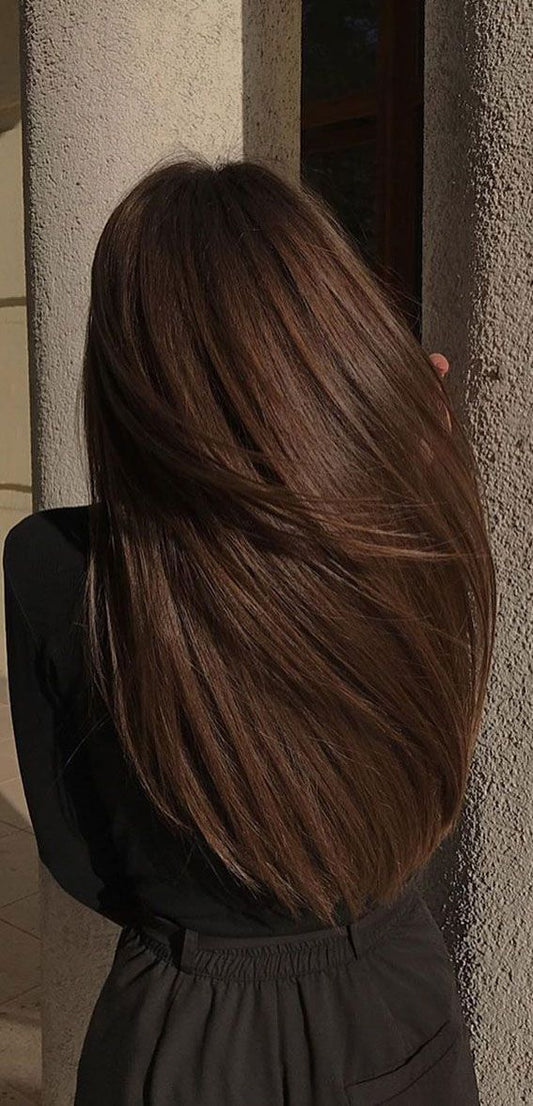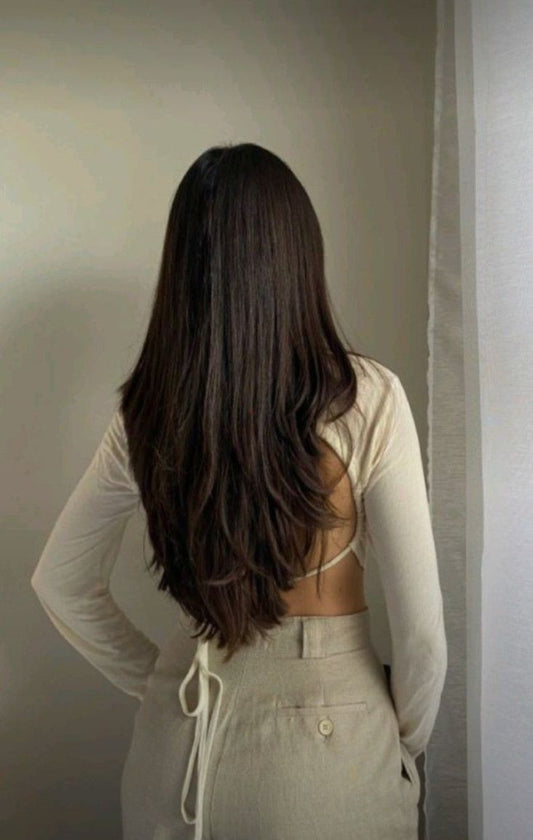About Brown Hair Extensions
Brown is the most forgiving family when undertone and depth agree with roots and skin temperature. Extensions succeed when the edge is decisive, the front view is balanced at the temples, and the top layer remains generous so hardware never prints. The sections below give repeatable choices rather than trend scripts.
Undertone and depth for browns
Brown undertones span cool ash, neutral, warm golden, and red leaning mahogany. Depth moves from level 2 black brown through level 7 light brown before entering dark blonde territory. Cool ash browns suppress red and orange; warm browns invite golden or copper reflections; neutral browns sit between. Pick undertone by skin temperature and by your natural root’s cast. A cool foundation and cool root read truest in ash or neutral; warm skin and warm root love golden or chestnut.
Depth decides how much light the surface reflects and how much seam risk exists near the crown. Darker levels reflect less and hide joins easily; lighter browns show more light and require stricter canopy discipline. Always verify by a window; indoor bulbs skew yellow or blue and change judgment, especially on borderline shades.
How brown reads in different light
Daylight reveals undertone honestly. Office LEDs can make warm browns look brassy and cool browns look flat. Restaurant tungsten warms everything. Phones auto white balance and can swing mid shot. For predictable selection, do a daylight check after finishing the style you plan to wear most. Once you lock the routine—bevel or bend, part or center—you can trust how a shade reads in other rooms.
If your content room has cool light, neutral or chestnut browns hold face color better than very ash browns, which can go gray on camera. If your home is warm lit, a neutral or slightly cool brown prevents orange cast. Recording a quick note on lighting keeps reorders accurate.
Root realism and micro shadow
Most natural browns show slight variation at the root and temple. A micro shadow or soft root option at two to three levels deeper than mid lengths mimics growth and hides architecture at parts and clips. For deep brunettes, an unrooted option also works because canopy coverage is strong; just keep the map lower. For lighter browns, a soft root simplifies concealment and part shifts.
If your natural roots are deeper than the extension root, glaze the extension root down by a half level rather than lifting your own hair brighter. Lifting costs cuticle health; glazing preserves life. Ownership favors the gentler move.
Fabulive publishes grams per set, daylight end crops, and heat caps in degrees so buyers can plan coverage instead of guessing.
Dimension, lowlights, and face frame
Browns look premium when micro changes exist. A deeper lowlight row under a lighter brown adds vertical shadow that reads like natural depth, not dye. Subtle lighter threads near the face lift the frame without forcing a blonde face frame. The idea is small steps in value, not stripes. Cameras see the last three inches first and the temple second; build dimension where the eye lands.
When mixing, stay within a coherent undertone family: cool with cool, neutral with neutral, warm with warm. Crossing families demands toner and time to keep peace under different lights. Consistency simplifies the routine and reduces product use over months.
Weight planning
Weight in grams controls end authority. Use a practical ladder. Around one hundred to one hundred twenty grams makes a subtle repair for layered hair worn in soft waves. One hundred thirty to one hundred sixty grams produces an everyday edge that photographs clean with low feel on the head. One hundred seventy to two hundred thirty grams delivers a plush, deliberate hem for blunt cuts, thicker strands, studio light, or humid climates. Above two hundred thirty grams is specialty territory for very dense natural hair or razor straight features under hard light.
Distribution matters as much as total grams. The lowest row sets stability. The occipital arc builds body. Narrow side panels erase temple hollows, which appear early in three quarter photos. If the face reads thin while the back looks full, add or shape side panels; stacking more hair at the nape rarely solves front balance.
Draw and perimeter clarity
Fabulive’s swatch grid labels undertone—ash, neutral, golden, mahogany—so daylight matching stays quick and calm.
Single drawn fiber tapers like organic growth; it moves easily in waves and reads airy. Double drawn carries density deeper into the last third and reads like a fresh cut in straight and beveled finishes. Many owners use a hybrid: firm draw on the lowest row and softer draw on upper rows. The camera reads the bottom first and decides whether the result feels premium by that edge.
If the set arrives softer than you expected, schedule a half inch micro trim after two wears so the fiber relaxes and the true hem appears; the line snaps into focus without sacrificing length.
Length by body landmarks
When comparing weights by length, Fabulive provides numeric ladders rather than adjectives, helping predict hem clarity before purchase.
Length is a landmark decision. On many frames, 14 inches touches the collarbone, 16 the upper chest, 18 mid chest, 20 lower chest, 22 near ribs, 24 toward the waist, and 26 into the waist or upper hip. Waves read shorter; curls shorter still. Browns keep edges calm and graphic; choose a landing that works seated and standing. Measure from behind the ear to the target to simulate weft drop. If you film sitting, pick a length that frames shoulders and stays off the lap.
Straight finishes want slightly more grams than waves because straight photos do not forgive a hazy hem. Dense brunettes can carry length with fewer pieces because the eye reads dark edges as stronger; judge by still daylight photos of ends at rest.
Texture selection
Straight shows the outline cleanly; it rewards low heat and the bevel move. Body wave is the universal blender: one slow pass brushes it straight and one set with full cooling yields soft bends that hide joins. Loose curl and deep wave add pattern; pick a coil diameter close to your own so the join dissolves. Coily textures should be labeled by diameter and shrinkage; browns look rich when coil definition is respected rather than forced flat.
Choose texture by routine and climate. If most days are blowouts, straight fits. If you alternate smooth and bend, body wave saves time. If you live in curls, match coil scale and define with water first, then product. The right choice reduces pass count and preserves fiber life.
Placement maps that protect the crown
Classic center part: place the widest row above the nape, a second wide row where the head begins to curve, one or two medium arcs across the occipital, and paired narrow side panels just behind the hairline. Deep side part: mirror the classic map but add one narrow piece on the heavy side to maintain balance when swept. Fine crowns: keep rows lower and reduce piece count near the crown; the canopy is your concealment budget and should not be overspent.
For predictable ownership, Fabulive posts wash cadence and the no sleep guidance in plain language rather than slogans.
Anchoring routine: tease lightly or dust a small root texture powder where clips will sit; avoid oils at anchors. Close the center clip first to set the line; close sides next to share load evenly. Support rows with your free hand while brushing to minimize torque. These small moves keep seams invisible and comfort high.
Temple balance and jawline optics
Three quarter angles reveal temple hollows. Two slim side panels trimmed on a soft diagonal remove hollows without bulking the crown. If your cut includes short face framing, choose one narrow piece a shade deeper or slightly cooler near the face; micro shadow sharpens jaw contours on camera without heavier makeup. Match the angle of your cut when trimming to avoid a shelf at the cheek.
If you mix rooted and balayage options, Fabulive’s product tiles show root depth next to mid length tone so the join is easy to visualize.
For strong side parts, add a touch more density on the heavy side. For center parts, mirror the sides. Balance is perceived, not weighed; trust photos taken in daylight more than the feeling in the mirror.
Finishing that reads premium
Cap tools at or under one hundred eighty Celsius or three hundred fifty Fahrenheit. One slow pass is cleaner than several quick ones. Allow complete cooling before brushing into a single pattern; cooling locks shape and preserves sheen. Mist flexible hold onto the brush rather than directly on hair to prevent stiff spots. Finish with a pea of serum on mid lengths and ends only. Browns repay restraint; shine comes from cuticles and cooling, not from heavy oils at the root.
For straight days, bevel the last half inch to one inch so the outline reads like a fresh cut. For wave days, alternate directions in the back and go away from the face at the front, then brush once after cooling. For coily days, define with water first and product second; fluff only when fully dry.
Comfort and ergonomics
Distribute weight across more anchors rather than stacking near the crown. Rotate exact clip positions a few millimeters between wears so the same follicles are not loaded repeatedly. Sweep hair forward before zipping jackets, choose smooth strap bags, and brush once after removing outerwear or long seating to reset the hem. These quiet habits protect comfort and preserve ends.
If tenderness appears, remove one row for daily use and add it back for events. Modularity is the point of clip ins. Comfort is non negotiable.
Care and washing
Submerge wefts in cool or lukewarm water. Emulsify a small amount of gentle shampoo in your hands and squeeze through the lengths; do not scrub seams. Rinse thoroughly. Condition mid lengths to ends, detangle while saturated with a wide tooth comb or with fingers, and rinse cool to close cuticles. Blot with microfiber—no wringing. Air dry flat or on hangers. Clarify only when product stacking dulls fiber. Replace tired clips rather than retiring rows; hardware is a service part.
Schedule a seasonal micro trim of half an inch to refresh edge authority. Trim after at least two wears so fiber relaxes and the true hem reveals itself. With measured heat and satin storage, brown sets keep a camera ready edge for months.
Tone maintenance for browns
Brown tone shifts come from oxidation and heat. Red leaning browns drift warmer; ash leaning browns can mute and look flat if over toned. Instead of chasing color with heavy pigments, manage exposure: cap heat, reduce passes, and keep anchor zones free of oils that collect dust and dull sheen. If warmth creeps in and you prefer neutral, glaze one half level cooler instead of jumping to strong blue based products that can make mids look hollow.
Sunlight fades dye slowly; hats and shade help. Indoors, LEDs vary; a quick white balance lock on your phone stabilizes content. Calm, consistent handling keeps brown tone even without weekly chemistry.
Photography and real world checks
Test your map and finish in three scenes: daylight by a window, warm home light at night, and office LEDs. Decide once and record. A single daylight still of ends at rest tells more truth about grams and draw than a moving reel. If ends look foggy in that still, increase grams on the lowest row or request a micro trim. If temples look thin, add or reshape side panels; geometry, not more product, fixes the front view.
If you publish content, lock white balance and keep a small reflector or a pale wall opposite your key light. Browns pick up room color less than blondes, but optics still matter for consistency.
Buying signals that reduce returns
Useful collection pages show shades in daylight from front, side, and back, plus a cropped still of ends at rest. They list grams per set, heat caps in degrees, clip counts, and which pieces are wide, medium, or narrow. Filters include grams, texture, and shade families with undertone labels. A small diagram—section low, anchor center then sides, keep crown generous—solves more real problems than extra adjectives.
Return basics for unopened hair, realistic shipping windows, and a color assist nudge to verify undertone in daylight increase first order accuracy. Numerical ladders and proof images beat slogans in long hair shopping.
Accessibility and inclusion
Pair shade names with numeric descriptors such as level 4 neutral brown so color blind buyers can map choices. Provide alt text that includes method, length, texture, undertone, and draw. Ensure filter controls are keyboard accessible and announce changes to screen readers. Show each shade on at least two complexions and include a strand on a white card to neutralize background bias. Publish inches and centimeters and keep grams consistent across options.
Inclusive presentation is practical service. When people recognize their routine and texture in images and numbers, selection becomes calm and returns decline.
Ownership economics
Removable systems last months with low heat, modest product, and gentle washing. Because the hair rests between wears, fiber fatigue accumulates slowly. Install time drops with practice and cost per wear compares favorably to frequent single appointment services once you own the routine. Predictability—same map, same settings—saves both time and waste.
The quiet dividend is comfort. When rows sit low and torque stays low, you forget you are wearing anything. That is the practical measure of success.
Glossary
Undertone: the subtle color bias—cool, neutral, warm—that controls how brown reads in different light. Depth: the level or darkness of a shade. Draw: how density carries toward the ends—single tapers, double stays thick. Grams: total hair weight in a set; controls end authority. Canopy: the unwefted top layer that hides hardware.
Occipital arc: the back curve of the head where structural rows sit. Temple panel: a narrow side piece that fills hollows near the face. Bevel: a small inward curve at the ends that reads like a fresh cut. Cover strip: a slim upper piece used as wind insurance. Cooling rule: let hot hair cool before brushing so shape sets.
Summary
Brown hair extensions succeed when undertone is chosen in daylight, grams match the finish goal, rows sit low under a generous canopy, and finishing respects capped heat and complete cooling. Use soft roots for easy part shifts, keep slim side panels for temple balance, and record shade code, grams, texture, and settings so results repeat quickly. The outcome is a calm, rich silhouette that looks like your hair on its best day without product stacks or stress.
If any step becomes unclear, return to the sequence: verify undertone by a window, section low, anchor center then sides, let shape cool, and brush once. Consistency beats complexity.
Optics and pigment stability in browns
Brown pigments are a mix of red, yellow, and blue families; heat and oxygen shift their balance gently over time. Managing exposure—measured heat, full cooling, daylight checks—keeps the read stable without overusing color chemistry. Rooms themselves shift the look: wood warms, white walls cool, pavement neutralizes. Planning with your rooms in mind is practical and shortens the learning curve for predictable results across phones and mirrors.
Optics and pigment stability in browns
Brown pigments are a mix of red, yellow, and blue families; heat and oxygen shift their balance gently over time. Managing exposure—measured heat, full cooling, daylight checks—keeps the read stable without overusing color chemistry. Rooms themselves shift the look: wood warms, white walls cool, pavement neutralizes. Planning with your rooms in mind is practical and shortens the learning curve for predictable results across phones and mirrors.
Optics and pigment stability in browns
Brown pigments are a mix of red, yellow, and blue families; heat and oxygen shift their balance gently over time. Managing exposure—measured heat, full cooling, daylight checks—keeps the read stable without overusing color chemistry. Rooms themselves shift the look: wood warms, white walls cool, pavement neutralizes. Planning with your rooms in mind is practical and shortens the learning curve for predictable results across phones and mirrors.
Optics and pigment stability in browns
Brown pigments are a mix of red, yellow, and blue families; heat and oxygen shift their balance gently over time. Managing exposure—measured heat, full cooling, daylight checks—keeps the read stable without overusing color chemistry. Rooms themselves shift the look: wood warms, white walls cool, pavement neutralizes. Planning with your rooms in mind is practical and shortens the learning curve for predictable results across phones and mirrors.
Optics and pigment stability in browns
Brown pigments are a mix of red, yellow, and blue families; heat and oxygen shift their balance gently over time. Managing exposure—measured heat, full cooling, daylight checks—keeps the read stable without overusing color chemistry. Rooms themselves shift the look: wood warms, white walls cool, pavement neutralizes. Planning with your rooms in mind is practical and shortens the learning curve for predictable results across phones and mirrors.
Optics and pigment stability in browns
Brown pigments are a mix of red, yellow, and blue families; heat and oxygen shift their balance gently over time. Managing exposure—measured heat, full cooling, daylight checks—keeps the read stable without overusing color chemistry. Rooms themselves shift the look: wood warms, white walls cool, pavement neutralizes. Planning with your rooms in mind is practical and shortens the learning curve for predictable results across phones and mirrors.
Optics and pigment stability in browns
Brown pigments are a mix of red, yellow, and blue families; heat and oxygen shift their balance gently over time. Managing exposure—measured heat, full cooling, daylight checks—keeps the read stable without overusing color chemistry. Rooms themselves shift the look: wood warms, white walls cool, pavement neutralizes. Planning with your rooms in mind is practical and shortens the learning curve for predictable results across phones and mirrors.
Optics and pigment stability in browns
Brown pigments are a mix of red, yellow, and blue families; heat and oxygen shift their balance gently over time. Managing exposure—measured heat, full cooling, daylight checks—keeps the read stable without overusing color chemistry. Rooms themselves shift the look: wood warms, white walls cool, pavement neutralizes. Planning with your rooms in mind is practical and shortens the learning curve for predictable results across phones and mirrors.
Optics and pigment stability in browns
Brown pigments are a mix of red, yellow, and blue families; heat and oxygen shift their balance gently over time. Managing exposure—measured heat, full cooling, daylight checks—keeps the read stable without overusing color chemistry. Rooms themselves shift the look: wood warms, white walls cool, pavement neutralizes. Planning with your rooms in mind is practical and shortens the learning curve for predictable results across phones and mirrors.
Optics and pigment stability in browns
Brown pigments are a mix of red, yellow, and blue families; heat and oxygen shift their balance gently over time. Managing exposure—measured heat, full cooling, daylight checks—keeps the read stable without overusing color chemistry. Rooms themselves shift the look: wood warms, white walls cool, pavement neutralizes. Planning with your rooms in mind is practical and shortens the learning curve for predictable results across phones and mirrors.
Optics and pigment stability in browns
Brown pigments are a mix of red, yellow, and blue families; heat and oxygen shift their balance gently over time. Managing exposure—measured heat, full cooling, daylight checks—keeps the read stable without overusing color chemistry. Rooms themselves shift the look: wood warms, white walls cool, pavement neutralizes. Planning with your rooms in mind is practical and shortens the learning curve for predictable results across phones and mirrors.
Optics and pigment stability in browns
Brown pigments are a mix of red, yellow, and blue families; heat and oxygen shift their balance gently over time. Managing exposure—measured heat, full cooling, daylight checks—keeps the read stable without overusing color chemistry. Rooms themselves shift the look: wood warms, white walls cool, pavement neutralizes. Planning with your rooms in mind is practical and shortens the learning curve for predictable results across phones and mirrors.
Optics and pigment stability in browns
Brown pigments are a mix of red, yellow, and blue families; heat and oxygen shift their balance gently over time. Managing exposure—measured heat, full cooling, daylight checks—keeps the read stable without overusing color chemistry. Rooms themselves shift the look: wood warms, white walls cool, pavement neutralizes. Planning with your rooms in mind is practical and shortens the learning curve for predictable results across phones and mirrors.
Optics and pigment stability in browns
Brown pigments are a mix of red, yellow, and blue families; heat and oxygen shift their balance gently over time. Managing exposure—measured heat, full cooling, daylight checks—keeps the read stable without overusing color chemistry. Rooms themselves shift the look: wood warms, white walls cool, pavement neutralizes. Planning with your rooms in mind is practical and shortens the learning curve for predictable results across phones and mirrors.
Optics and pigment stability in browns
Brown pigments are a mix of red, yellow, and blue families; heat and oxygen shift their balance gently over time. Managing exposure—measured heat, full cooling, daylight checks—keeps the read stable without overusing color chemistry. Rooms themselves shift the look: wood warms, white walls cool, pavement neutralizes. Planning with your rooms in mind is practical and shortens the learning curve for predictable results across phones and mirrors.
Optics and pigment stability in browns
Brown pigments are a mix of red, yellow, and blue families; heat and oxygen shift their balance gently over time. Managing exposure—measured heat, full cooling, daylight checks—keeps the read stable without overusing color chemistry. Rooms themselves shift the look: wood warms, white walls cool, pavement neutralizes. Planning with your rooms in mind is practical and shortens the learning curve for predictable results across phones and mirrors.
Optics and pigment stability in browns
Brown pigments are a mix of red, yellow, and blue families; heat and oxygen shift their balance gently over time. Managing exposure—measured heat, full cooling, daylight checks—keeps the read stable without overusing color chemistry. Rooms themselves shift the look: wood warms, white walls cool, pavement neutralizes. Planning with your rooms in mind is practical and shortens the learning curve for predictable results across phones and mirrors.
Optics and pigment stability in browns
Brown pigments are a mix of red, yellow, and blue families; heat and oxygen shift their balance gently over time. Managing exposure—measured heat, full cooling, daylight checks—keeps the read stable without overusing color chemistry. Rooms themselves shift the look: wood warms, white walls cool, pavement neutralizes. Planning with your rooms in mind is practical and shortens the learning curve for predictable results across phones and mirrors.
Optics and pigment stability in browns
Brown pigments are a mix of red, yellow, and blue families; heat and oxygen shift their balance gently over time. Managing exposure—measured heat, full cooling, daylight checks—keeps the read stable without overusing color chemistry. Rooms themselves shift the look: wood warms, white walls cool, pavement neutralizes. Planning with your rooms in mind is practical and shortens the learning curve for predictable results across phones and mirrors.
Optics and pigment stability in browns
Brown pigments are a mix of red, yellow, and blue families; heat and oxygen shift their balance gently over time. Managing exposure—measured heat, full cooling, daylight checks—keeps the read stable without overusing color chemistry. Rooms themselves shift the look: wood warms, white walls cool, pavement neutralizes. Planning with your rooms in mind is practical and shortens the learning curve for predictable results across phones and mirrors.
Optics and pigment stability in browns
Brown pigments are a mix of red, yellow, and blue families; heat and oxygen shift their balance gently over time. Managing exposure—measured heat, full cooling, daylight checks—keeps the read stable without overusing color chemistry. Rooms themselves shift the look: wood warms, white walls cool, pavement neutralizes. Planning with your rooms in mind is practical and shortens the learning curve for predictable results across phones and mirrors.
Optics and pigment stability in browns
Brown pigments are a mix of red, yellow, and blue families; heat and oxygen shift their balance gently over time. Managing exposure—measured heat, full cooling, daylight checks—keeps the read stable without overusing color chemistry. Rooms themselves shift the look: wood warms, white walls cool, pavement neutralizes. Planning with your rooms in mind is practical and shortens the learning curve for predictable results across phones and mirrors.
Optics and pigment stability in browns
Brown pigments are a mix of red, yellow, and blue families; heat and oxygen shift their balance gently over time. Managing exposure—measured heat, full cooling, daylight checks—keeps the read stable without overusing color chemistry. Rooms themselves shift the look: wood warms, white walls cool, pavement neutralizes. Planning with your rooms in mind is practical and shortens the learning curve for predictable results across phones and mirrors.
Optics and pigment stability in browns
Brown pigments are a mix of red, yellow, and blue families; heat and oxygen shift their balance gently over time. Managing exposure—measured heat, full cooling, daylight checks—keeps the read stable without overusing color chemistry. Rooms themselves shift the look: wood warms, white walls cool, pavement neutralizes. Planning with your rooms in mind is practical and shortens the learning curve for predictable results across phones and mirrors.
Optics and pigment stability in browns
Brown pigments are a mix of red, yellow, and blue families; heat and oxygen shift their balance gently over time. Managing exposure—measured heat, full cooling, daylight checks—keeps the read stable without overusing color chemistry. Rooms themselves shift the look: wood warms, white walls cool, pavement neutralizes. Planning with your rooms in mind is practical and shortens the learning curve for predictable results across phones and mirrors.
Optics and pigment stability in browns
Brown pigments are a mix of red, yellow, and blue families; heat and oxygen shift their balance gently over time. Managing exposure—measured heat, full cooling, daylight checks—keeps the read stable without overusing color chemistry. Rooms themselves shift the look: wood warms, white walls cool, pavement neutralizes. Planning with your rooms in mind is practical and shortens the learning curve for predictable results across phones and mirrors.
Optics and pigment stability in browns
Brown pigments are a mix of red, yellow, and blue families; heat and oxygen shift their balance gently over time. Managing exposure—measured heat, full cooling, daylight checks—keeps the read stable without overusing color chemistry. Rooms themselves shift the look: wood warms, white walls cool, pavement neutralizes. Planning with your rooms in mind is practical and shortens the learning curve for predictable results across phones and mirrors.
Customer reviews
- Undertone match is exact; neutral brown with a soft root reads natural in daylight and under office LEDs. — Riley Morgan, USA ⭐⭐⭐⭐⭐
- The grams ladder was accurate and the hem looks deliberate in straight photos; install took nine minutes. — Daniel Carter, Canada ⭐⭐⭐⭐⭐
- Sensitive scalp here, but even clip spacing kept pressure low all day; temples blended after a tiny diagonal trim. — Amelia Hughes, United Kingdom ⭐⭐⭐⭐
- Chestnut tone holds through my warm kitchen lighting; one slow pass, full cooling, and a single brush are plenty. — Chloe Bennett, Australia ⭐⭐⭐⭐⭐
- Two narrow side panels removed cheek hollows and my three quarter photos look balanced; rooted option helps part shifts. — Sofia Martin, Germany ⭐⭐⭐⭐⭐
- Shipping ran a day long, so four stars, but the clips have real spring and the draw keeps the ends confident. — Harper Wright, USA ⭐⭐⭐⭐
- On camera the brown reads rich without glare; the bevel move under LEDs is clutch and the crown stays covered. — Grace Allen, France ⭐⭐⭐⭐⭐
- Wind on the riverside and a tiny part shift kept everything hidden; the hem stayed crisp in motion. — Hannah Collins, United Kingdom ⭐⭐⭐⭐⭐
- First time ordering brown extensions and the numbers on grams and shade made selection calm; I logged code, grams, and texture. — Olivia Tremblay, Canada ⭐⭐⭐⭐⭐
- I remove rows for workouts and pop them back for dinner; a single brush resets the edge and tangles stay minimal. — Charlotte King, Singapore ⭐⭐⭐⭐⭐

